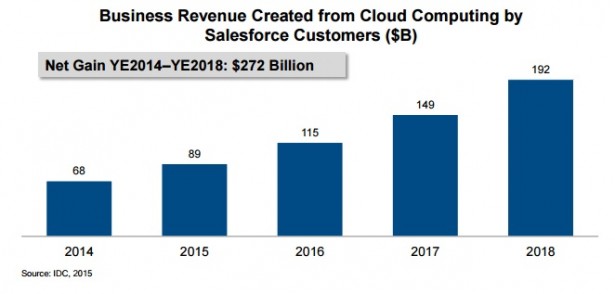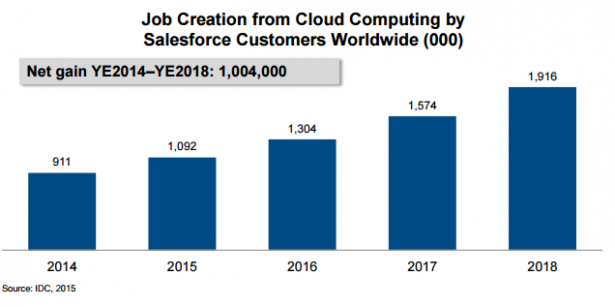How the Salesforce Ecosystem Will Add $272B to Local Economies Through 2018
Long before “the cloud” was a term used in everyday language, Salesforce was singing its praises.
Since 1999 when the company first opened its physical and virtual doors, Salesforce has grown to include thousands of partners, 2,800 apps on the Salesforce AppExchange and more than 150,000 customers, and according to a recent IDC report, it’s not slowing down anytime soon.
The report on the Salesforce economy released last month predicts between the end of 2014 and the end of 2018, Salesforce and its ecosystem of customers and partners will generate $272 billion in GDP impact to their local economies and create 1 million jobs worldwide.
 Cloud computing generates jobs primarily from permitting an increase in IT innovation, which in turn supports business innovation and increased GDP in local markets. The United States, because of its large share of cloud implementations and share of Salesforce’s global revenue, will generate more than 50% of the world’s financial gain from the Salesforce customer set, but about 60% of the jobs will be created in emerging markets where labor costs are low.
Cloud computing generates jobs primarily from permitting an increase in IT innovation, which in turn supports business innovation and increased GDP in local markets. The United States, because of its large share of cloud implementations and share of Salesforce’s global revenue, will generate more than 50% of the world’s financial gain from the Salesforce customer set, but about 60% of the jobs will be created in emerging markets where labor costs are low.
Those direct jobs will engender another 1.5 million indirect or induced jobs as increased customer revenue drives jobs in supply and distribution chains, and as new employees spend money in the general economy.
 The Salesforce ecosystem currently generates 2.8 times the revenues of Salesforce itself and is expected to grow to 3.7 times as large as Salesforce. This is a function of the Salesforce partner network and the expected growth in its products and services, as customer implementations become more customized and deadline-driven.
The Salesforce ecosystem currently generates 2.8 times the revenues of Salesforce itself and is expected to grow to 3.7 times as large as Salesforce. This is a function of the Salesforce partner network and the expected growth in its products and services, as customer implementations become more customized and deadline-driven.
The growth trickles down to the local level when ecosystem services such as IT consulting, training and provision or ancillary hardware, software and networking are often performed by local IT firms.